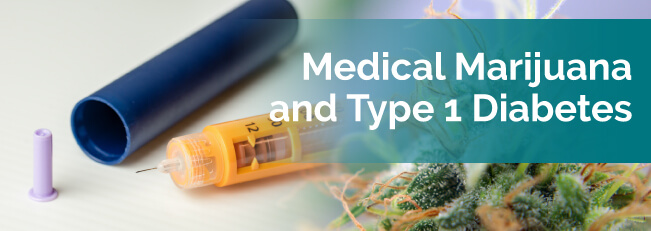
Although a main talking point of marijuana today is its recreational purpose, the medicinal uses of this herb have been utilized for thousands of years. Due to advancements in research and technology, we continue to find medicinal benefits of marijuana. In fact, research now shows us a correlation between medical marijuana use and the treatment of type 1 diabetes. Let’s explore the effect of medical marijuana on type 1 diabetes, as well as the benefits that this form of treatment can provide to individuals struggling with this disease.
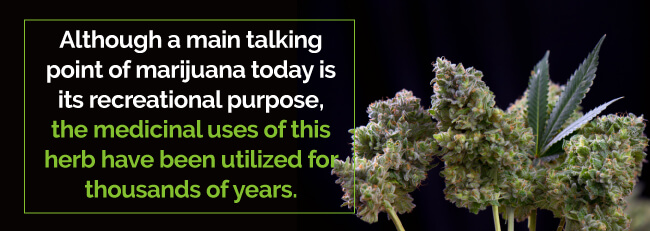
An interesting factor associated with cannabinoids is a high lipid-soluble ability, meaning they tend to stay in your body for extended periods of time. Although your liver breaks down the THC into THC-COOH, the chemical can stay in your body for around four days if you use cannabis occasionally, and up to 67 days if you use it more regularly.
Find A Doctor Find A Dispensary
Medical marijuana works extremely capably as an anti-inflammatory treatment and does not pose the same side effects as steroids. Because people who have diabetes are recommended to avoid steroids at all costs, this is essential. Due to the fact that diabetics are more prone to develop arterial inflammation, cannabinoids basic properties are of significant interest.
Medical marijuana also treats diabetics because it offers neuroprotective properties, which results in it helping to protect nerve coverings from inflammatory attacks that are thought to be caused by glycoproteins in the blood. This also lessens the neuropathic pain individuals with diabetes experience. Because marijuana activates receptors throughout the body and brain, it helps manage your mind, body and overall well-being.
Research on marijuana and type 1 diabetes treatment is ongoing, and advancing.
According to a The American Alliance for Medical Cannabis ( AAMC) 2005 published paper, diabetic individuals can use cannabis to:
Recently, researchers have been focusing on these benefits of medical cannabis for type 1 diabetes, in addition to seeking out further benefits that advanced research can uncover.
The compounds in cannabis have also been shown to be effective at reducing fluid pressure in the eye, known as intraocular pressure, significantly in individuals with glaucoma: a disease that is associated with diabetic retinopathy.
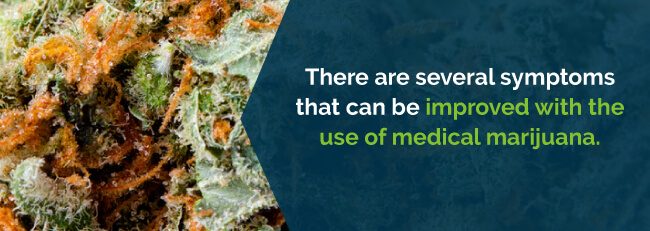
There are several symptoms that can be improved with the use of medical marijuana. The improvements to type 1 diabetes symptoms include:
Additionally, certain compounds in medical marijuana might reduce fasting glucose and improve insulin resistance, early studies suggest.
THC, the main psychoactive in marijuana, may ease discomfort and pain. However, lesser-known cannabinoids, like CBD and THCV, have both displayed anti-diabetic properties.
Other benefits of marijuana for type 1 diabetes include:
CBD, in particular, has the potential to reduce the occurrence of type 1 diabetes, or even delay its onset. This cannabinoid also shows anti-autoimmune properties.
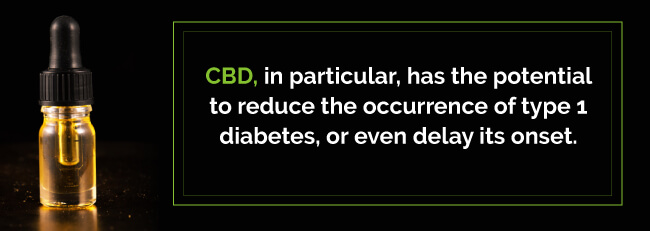
Unfortunately, finding medical marijuana products high in CBD and THCV can be difficult. Until there are more strains grown specifically to help people with diabetes, patients are left with only a small handful of strains to choose from. However, with some effort, you may find some strains that are worth considering.
Strains that are high in CBD and THCV include:
Cannabis for type 1 diabetes treatment can be consumed in a variety of methods. Here are a few common ones:
With this method, you’re heating the dried plant rather than burning it. This extracts the THC from the plant, allowing you to inhale.
Smoking is another common method. Physicians acknowledge that it’s the most favorable way take marijuana.
Edibles are an effective method, but you may experience delayed effects from the cannabis. Also, they may become stronger as your stomach absorbs the herb. The amount of time before you feel its effects depends on how much you consume, and how frequently you ingest it. Your metabolism also plays a role.
If your metabolism is slow, you may be waiting a couple of hours before you feel the effect. On the other hand, if you have a fast metabolism, you’ll likely experience the full effect within an hour. Therefore, one must be careful to avoid taking an extra dose, particularly if it’s the first time using this form of ingestion.
The AAMC suggests using topical cannabis treatments made with oils like Aloe Vera. You can apply it to your feet and hands directly, and this has been shown to decrease tingling sensations and pain that often complement diabetic neuropathy.
You’ll find a whole range of hemp and CBD lotions, oils and balms available. Since they typically don’t contain THC, they’re non-psychoactive.
There are a few other ways to use medical marijuana, including the use of suppositories and tinctures, as well as dabbing. You can read more about these methods here.
As research continues to provide more insight into the treatment and management of type 1 diabetes, it’s imperative to provide valuable resources for those suffering from this disease, particularly if those resources can offer some relief.
MarijuanaDoctors.com makes it easy for you to choose your cannabis for type 1 diabetes product or locate a physician.
Find A Doctor Find A Dispensary
Previously referred to as juvenile diabetes, or insulin-dependent diabetes, type 1 diabetes is a chronic condition in which your pancreas produces little to no insulin. Humans need the hormone insulin, as it allows glucose (sugar) to enter your cells: an imperative process for energy production. Insulin helps glucose move into the tissues of your body. At this point, cells can use the glucose for fuel.
Factors within the body that may directly contribute to Type 1 diabetes includes a person’s genetic makeup and their exposure and resistance to certain viruses. Although it is typical for juvenile diabetes to appear during childhood or adolescence, it can also develop in adults or during later stages of life.
Although researchers are conducting many active scientific research projects on Type 1 diabetes, there is currently no cure. However, individuals can manage the condition. Those who treat Type 1 diabetes, or insulin-dependent diabetes, can expect to live a longer and healthier life than they have in the past.
It wasn’t until the 19th century that medical literature cited fatal ketoacidosis in children and young adults. The journey from the 19th century to today has involved notable advancement in the methodology and understanding of treatment for type 1 diabetes.
Between 1921-1922, the discovery of insulin provided a new treatment approach. During this time, the public learned that the chances of surviving the condition related closely to the person’s age upon diagnosis.
Between the years 1980-2012, the number of adults in the U.S. who received a diagnosis of diabetes almost quadrupled, increasing from 5.5 million to 21.3 million.
However, preventative care for diabetic adults has significantly improved over the past 20 years in the U.S. Over the years, there have been improved advocacy and advancements for the disease. Islet transplantation and clinical stem cell trials provide further hope for a future cure.
Type 1 diabetes can cause a wide variety of symptoms, but the effect of this disease presents a few commonalities between those who suffer from it. With type 1 diabetes, a body’s cells don’t receive the necessary amount of glucose to properly function, due to a lack of insulin. Instead, the glucose backs up in blood, starving cells and leading to high blood sugar.
High blood sugar can cause:
When your blood has an extra buildup of sugar, you urinate more, a result of your body attempting to eliminate this excess. Every time you urinate, you lose significant amounts of water, which leads to your body becoming dehydrated.
As glucose leaves your body through your urine, calories go with it. Because of this, many people who have high blood sugar end up losing weight.
When your body can’t fuel itself through glucose, it turns to breaking down your fat cells instead, creating chemicals known as ketones. In humans, the liver releases stored sugar, but without insulin, human bodies can’t utilize it. As a result, sugar and acidic ketones build up in the blood. The combination of dehydration, extra glucose and ketoacidosis (acid buildup) can be fatal if it’s not treated immediately.
High levels of glucose in your blood over time can harm your small blood vessels, as well as the nerves in your kidneys, eyes and heart. This can also increase your risk of atherosclerosis (hardening of your arteries), leading to stroke or heart attack.
Symptoms of type 1 diabetes are usually subtle at first, but they can increase in severity. Symptoms may include:
Many consider type 1 diabetes to be just a physical ailment, and they neglect to discuss the mental aspects of the disease. Although there are individuals who have diabetes in addition to a mental health disorder, some struggle with mental issues that fall outside of a mental health diagnosis. Patients often feel overwhelmed with the necessary steps required to manage their diabetes, and that extends to both physical, and mental, symptoms.
Living with type 1 diabetes can lead to uncomfortable and unpleasant emotions. Diabetes is a chronic disease, and trying to balance everything that comes with diabetes management can be frustrating and unpredictable.
If diabetes is not properly managed, it can lead to feelings of guilt, anxiety and even hopelessness. These feelings are only one part of the overall emotional impact that a chronic disease can, and likely will, have on the sufferer.
Type 1 diabetes impacts daily life, and can influence interactions with others, particularly when it comes to the relationships you have with your loved ones and friends. Negative emotions like stress can affect your ability to have relationships, or your ability to be present in them. Some people get anxious, depressed and feel helpless, and it can be difficult to go to school, work or simply enjoy daily activities.
The SEARCH for Diabetes in Youth study revealed these statistics:
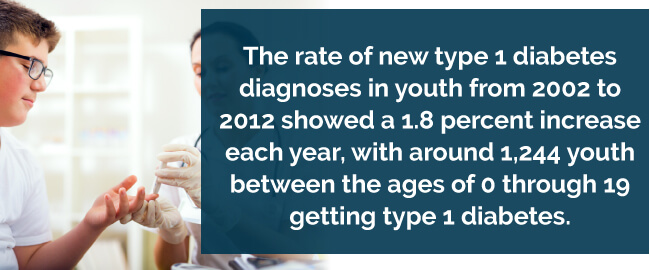
Other facts reported by JDRF show:
Although research is ongoing, there is still no known cure for type 1 diabetes. Treatment centers aim to manage type 1 diabetes by monitoring levels of blood sugar with insulin, as well as overseeing lifestyle and diet alterations, if necessary, to avoid complications.
Those with a diagnosis of type 1 diabetes require insulin to keep blood sugar levels under control. There are a few types of insulin:
Physicians might start treatment with a couple of injections daily and utilize one or more types of insulin. Treatment eventually progresses to three to four shots a day, and the use of an insulin pump may be required depending on circumstance.
Side Effects of Insulin:
The most common, and most serious, side effect of insulin is hypoglycemia. Some experience an ocular disturbance known as bilateral presbyopia (blurred vision) at the start of therapy. Occasionally, dermatologic reactions can occur to insulin, resulting in lipoatrophy or lipohypertrophy.
Although rare, either systemic or local hypersensitivity reactions can occur. Immunologic responses like anti-insulin antibody formation are uncommon but cited, especially with animal insulin formulations. Weight gain or gastrointestinal distress is also a rare side effect that’s associated with insulin.
Exercise is an important part of type 1 diabetes treatment. However, this often includes more than a daily jog around the neighborhood. All physical activity should be balanced with a proper diet and prescribed insulin dose, even if you’re just doing housework or tasks around the yard.
Be sure to check blood sugar before, during and after exercise to see how it affects you. Your levels may go up because of a particular activity, while other activities have no response. To prevent sugar levels from getting too low, you may need to eat a carb-rich snack or lower your insulin.
With type 1 diabetes, your diet should include making healthy choices to maximize the nutrition you get in each calorie, and insulin should be matched with adequate carbohydrate intake. Following a low glycemic index diet is the simplest way to match your carbs to your insulin, since it has a more gradual impact of carbs on your blood sugar.
Injecting insulin can cause weight gain, so your diet should be healthy, and low in calories, to manage or lose weight, if necessary. Obtaining a food list of different low glycemic options can help you learn what you should include in your diet. It’s prudent to work with your physician and a dietician to manage your diet when you have type 1 diabetes.
Your risk of diabetes-related distress and depression increases when you have diabetes. Because of this, a common component of a well-rounded treatment plan includes sessions with a psychologist or social worker.
An interesting factor associated with cannabinoids is a high lipid-soluble ability, meaning they tend to stay in your body for extended periods of time. Although your liver breaks down the THC into THC-COOH, the chemical can stay in your body for around four days if you use cannabis occasionally, and up to 67 days if you use it more regularly.
Medical marijuana works extremely capably as an anti-inflammatory treatment and does not pose the same side effects as steroids. Because people who have diabetes are recommended to avoid steroids at all costs, this is essential. Due to the fact that diabetics are more prone to develop arterial inflammation, cannabinoids basic properties are of significant interest.
Medical marijuana also treats diabetics because it offers neuroprotective properties, which results in it helping to protect nerve coverings from inflammatory attacks that are thought to be caused by glycoproteins in the blood. This also lessens the neuropathic pain individuals with diabetes experience. Because marijuana activates receptors throughout the body and brain, it helps manage your mind, body and overall well-being.
Research on marijuana and type 1 diabetes treatment is ongoing, and advancing.
According to a The American Alliance for Medical Cannabis ( AAMC) 2005 published paper, diabetic individuals can use cannabis to:
Recently, researchers have been focusing on these benefits of medical cannabis for type 1 diabetes, in addition to seeking out further benefits that advanced research can uncover.
The compounds in cannabis have also been shown to be effective at reducing fluid pressure in the eye, known as intraocular pressure, significantly in individuals with glaucoma: a disease that is associated with diabetic retinopathy.

There are several symptoms that can be improved with the use of medical marijuana. The improvements to type 1 diabetes symptoms include:
Additionally, certain compounds in medical marijuana might reduce fasting glucose and improve insulin resistance, early studies suggest.
THC, the main psychoactive in marijuana, may ease discomfort and pain. However, lesser-known cannabinoids, like CBD and THCV, have both displayed anti-diabetic properties.
Other benefits of marijuana for type 1 diabetes include:
CBD, in particular, has the potential to reduce the occurrence of type 1 diabetes, or even delay its onset. This cannabinoid also shows anti-autoimmune properties.

Unfortunately, finding medical marijuana products high in CBD and THCV can be difficult. Until there are more strains grown specifically to help people with diabetes, patients are left with only a small handful of strains to choose from. However, with some effort, you may find some strains that are worth considering.
Strains that are high in CBD and THCV include:
Cannabis for type 1 diabetes treatment can be consumed in a variety of methods. Here are a few common ones:
With this method, you’re heating the dried plant rather than burning it. This extracts the THC from the plant, allowing you to inhale.
Smoking is another common method. Physicians acknowledge that it’s the most favorable way take marijuana.
Edibles are an effective method, but you may experience delayed effects from the cannabis. Also, they may become stronger as your stomach absorbs the herb. The amount of time before you feel its effects depends on how much you consume, and how frequently you ingest it. Your metabolism also plays a role.
If your metabolism is slow, you may be waiting a couple of hours before you feel the effect. On the other hand, if you have a fast metabolism, you’ll likely experience the full effect within an hour. Therefore, one must be careful to avoid taking an extra dose, particularly if it’s the first time using this form of ingestion.
The AAMC suggests using topical cannabis treatments made with oils like Aloe Vera. You can apply it to your feet and hands directly, and this has been shown to decrease tingling sensations and pain that often complement diabetic neuropathy.
You’ll find a whole range of hemp and CBD lotions, oils and balms available. Since they typically don’t contain THC, they’re non-psychoactive.
There are a few other ways to use medical marijuana, including the use of suppositories and tinctures, as well as dabbing. You can read more about these methods here.
As research continues to provide more insight into the treatment and management of type 1 diabetes, it’s imperative to provide valuable resources for those suffering from this disease, particularly if those resources can offer some relief.
MarijuanaDoctors.com makes it easy for you to choose your cannabis for type 1 diabetes product or locate a physician.
Find A Doctor Find A Dispensary


Please allow us to access your location to find local dispensaries.
VIEW ALL DISPENSARIES ➔